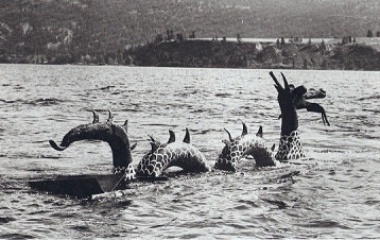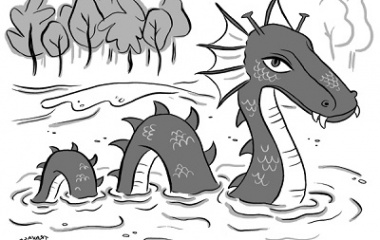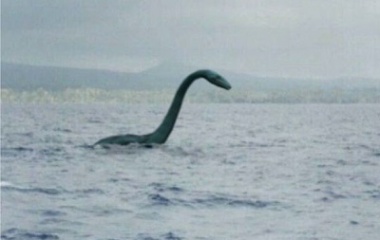In 1926, 30 cars full of people on the shore of Lake Okanagan in British Columbia, Canada, witnessed something that would haunt them for the rest of their lives. A series of huge, serpentine humps rose and fell through the calm lake waters, cutting a large wake behind them. All the witnesses agreed that the humps must belong to the lake’s resident monster, Ogopogo, making this one of the most credible monster sightings ever documented.
What is Ogopogo?
Ogopogo is a lake monster, usually seen as a series of humps moving across the surface of Canada’s Lake Okanagan. History is littered with sightings of the giant lake serpent, and many cryptozoologists have conducted research about him. To date, there is no conclusive evidence that can confirm or deny the idea that the elusive Ogopogo does, indeed, lurk in the depths of Lake Okanagan.
Characteristics
Physical Description
The monster is usually described as having a snake-like body, measuring anywhere from 15-40 feet long. Atop his body is a head said by various people to resemble a snake, a horse, or even a goat. Long ears or horns adorn the monster’s head in some descriptions, and his skin is deep blue or dark brown.
Behavior
According to early Native American descriptions,
Lake Okanagan’s monster is a violent, flesh-eating predator capable of turning humans into prey.
Early Native Americans would not travel across Lake Okanagan without having livestock on board their crafts, ready to be sacrificed to the hungry beast.
Today, Native Americans believe that the monster’s home is on a barren island called Rattlesnake Island. In addition to his island home, Ogopogo also frequents the headwaters of some of the rivers that spill into Lake Okanagan.
Related Creatures
Scotland’s Loch Ness Monster springs to mind for many people when they hear about Ogopogo for the first time. Like Ogopogo, Nessie is a lake-dwelling creature who is often seen moving in serpentine humps. However, sightings of Ogopogo predate Nessie’s rise to stardom by about seven years, so it’s unlikely that the sightings at Loch Ness inspired the sightings at Lake Okanagan.
It’s much more likely that Ogopogo was inspired by Native American tales of an ancient monster called N’ha-a-tik (“snake in the lake”), who is similar in appearance and who inhabits the same waters as the current monster.
Cultural Representation
Native American Tradition
Long before the first sighting of Ogopogo, Native American tradition held that Lake Okanagan was inhabited by a terrifying creature called N’ha-a-tik. It’s unclear whether N’ha-a-tik was a literal monster or merely a spirit that, if provoked, could ravage any life in its path. Whether N’ha-a-tik had a corporeal form or not, the native people certainly feared him and credited him with supernatural powers.
Modern Sightings
If you dig into the archives of local newspapers, you can find documented sightings of a monster in Lake Okanagan that date back all the way to 1872. The decades between then and now are sprinkled with testimonies, photos, and even video clips of the monster.
In 1914, a group of Nicola Valley and Westbank Native Americans discovered a strange carcass near Rattlesnake Island. The carcass weighed in at 400 pounds and was between five and six feet long. It was blue-ish grey in color, and it had flippers and a tail. Most people believed the carcass was a manatee, although it was unclear how a manatee could have gotten into Lake Okanagan. A small sect of people supported the idea that the carcass belonged to Ogopogo and that the beast’s long neck had been detached as the carcass decomposed.
In 1926, Ogopogo was spotted by 30 carloads of people, as previously described. A couple of decades later, in 1947, people aboard a group of several boats reported seeing the beast. These multiple-witness accounts have helped to set Ogopogo apart from other legendary creatures. Many cryptozoologists consider that the evidence for Ogopogo is even stronger than the evidence for his famous Scottish counterpart, Nessie.
In 1968, a man named Arthur Folden shot the most compelling video footage of Ogopogo. In Folden’s video, an animal is moving across the lake, leaving behind a tremendous wake. In 2011, another video was produced by Richard Huls. The video also shows a large wake moving across the lake.
Photographs of Ogopogo turn up on a regular basis. The most widely known photos include the 1964 Parmenter photo; the 1976 Fletcher photo; the 1978, 1979 and 1981 Gaal photos; the 1981 Wachlin photo; and the 1984 Svensson photograph. The photos show either a large wake or a series of low, broken humps in the water.
In total, over 200 eye witness accounts have bolstered Ogopogo’s lore. These accounts often find their way into local newspapers, where they become immortal pieces of the legend.
Investigations
The sheer volume of reported Ogopogo sightings has drawn countless cryptozoologists to Lake Okanagan’s shores over the years. Many hours of video analysis and even underwater exploration have been devoted to dredging up the truth about the lake’s resident monster.
In 1991, an underwater expedition surveyed the depths of Lake Okanagan with a remotely operated vehicle and a miniature submarine. Despite the devices probing as deep as 840 feet into the belly of the lake, no evidence of Ogopogo turned up.
In 2005, the National Geographic TV show Is It Real? featured Ogopogo in one of its episodes. The acclaimed cryptozoologists Benjamin Radford, Joe Nickell, and John Kirk analyzed footage of the creature, ultimately concluding that the images had not captured a monster.
Art and Literature
In addition to a number of non-fiction books which have been written on the legend of Ogopogo, the lake monster also pops up in the entertainment side of art and literature.
The name “Ogopogo” was taken from a British music hall tune called “The Ogo-pogo: the Funny Fox-trot.” The song was popular around 1924, when Lake Okanagan’s monster was beginning to grow in fame. Since then, Ogopogo has appeared in the Nancy Drew book series, the popular Final Fantasy video game series, and even on Canadian postage stamps.
Explanations of the Myth
While Ogopogo is no more than a fun, slightly comedic tourist attraction in the eyes of most people, debate about the monster’s existence can get heated among cryptozoologists or staunch, local believers.
A number of prominent cryptozoologists have dismissed photo and video evidence of Ogopogo as cases of mistaken identity. The awe-inspiring wake in the famous Folden footage is usually credited to a beaver. Likewise, the more recent Huls video is said to be two logs floating side by side. Skeptics note that Lake Okanagan is full of wildlife and logs, which are floated across the lake by the local timber industry. Any of these objects could appear monstrous, if they were seen from the wrong angle.
Believers usually assert that Ogopogo is a member of a species that was previously believed to be extinct. Many believers think he could be a Basilosaurus, a sort of primitive, serpentine whale, or a Plesiosaur, a long-necked, marine reptile.










